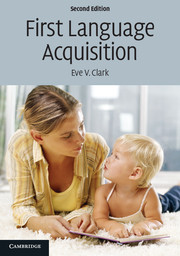Book contents
- Frontmatter
- Contents
- List of tables, boxes, and figures
- Acknowledgements
- 1 Acquiring language: Issues and questions
- Part I Getting started
- 2 In conversation with children
- 3 Starting on language: Perception
- 4 Early words
- 5 Sounds in words: Production
- 6 Words and meanings
- Part II Constructions and meanings
- Part III Using language
- Part IV Process in acquisition
- Glossary
- References
- Name index
- Subject index
2 - In conversation with children
from Part I - Getting started
- Frontmatter
- Contents
- List of tables, boxes, and figures
- Acknowledgements
- 1 Acquiring language: Issues and questions
- Part I Getting started
- 2 In conversation with children
- 3 Starting on language: Perception
- 4 Early words
- 5 Sounds in words: Production
- 6 Words and meanings
- Part II Constructions and meanings
- Part III Using language
- Part IV Process in acquisition
- Glossary
- References
- Name index
- Subject index
Summary
Infants are born into a social world, a world of touch, sound, and affect, a world of communication. They develop and grow up as social beings, immersed in a network of relationships from the start. It is in this social setting that they are first exposed to language, to language in use. This language forms part of the daily communication around them and to them. It regulates what they do. It tells them about the world, events, actions, objects, and relations within it, and presents them with affective attitudes to people and events. In short, language is a central factor in the social life of infants. The users of language they are exposed to provide the context in which children themselves become proficient at communicating wants and desires, affect and interest, requests and instructions, questions and observations, and commentary on all the contents of everyday life.
This chapter explores the social setting in which children are exposed to language, respond to it, and begin to use it. It is in and from interaction that children are offered conventional ways of expressing attitudes and of saying things, along with the conventional words and expressions for what they appear to be trying to say. And it is in interaction that children take up these words, expressions, and constructions. Language can be used for talking about needs and desires, or objects and events in the world at large; for talking about how to behave, how to act, what to say in different circumstances; for talking about problem-solving, for expository argument or explanation, for giving instructions; and for pretending, teasing, joking, or telling stories.
- Type
- Chapter
- Information
- First Language Acquisition , pp. 21 - 50Publisher: Cambridge University PressPrint publication year: 2009
- 1
- Cited by



